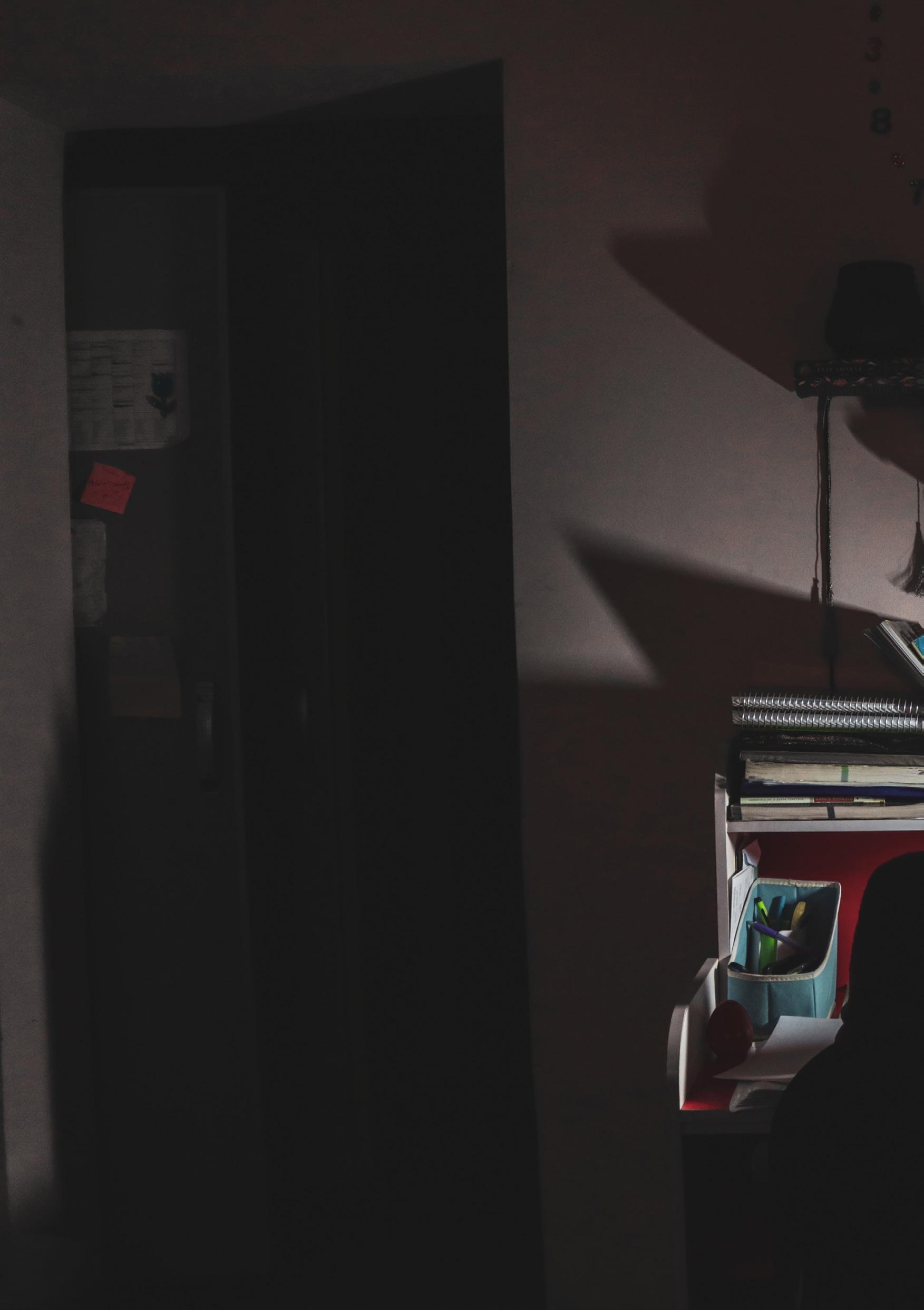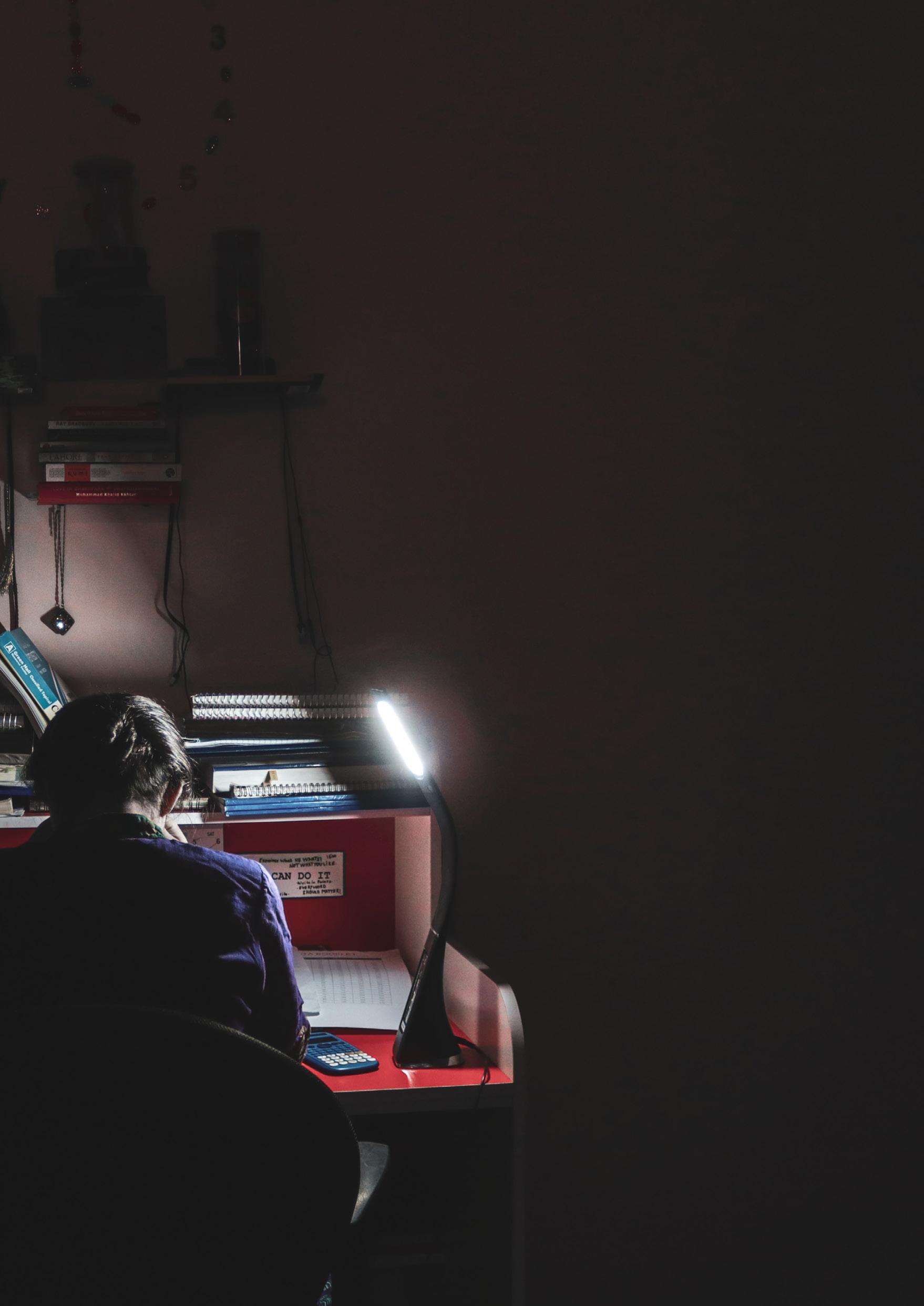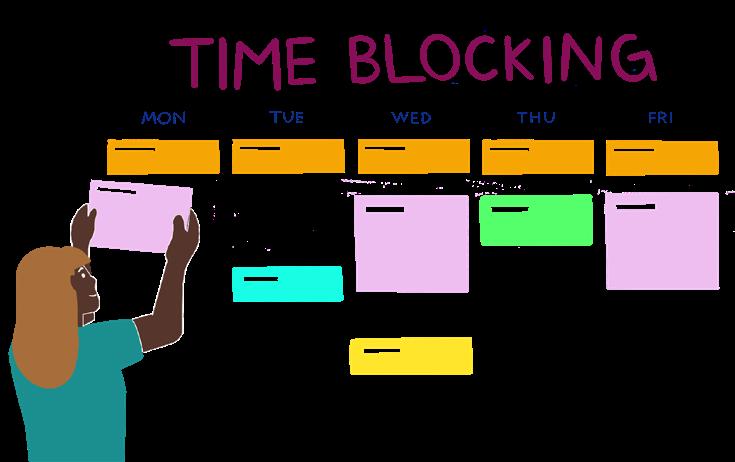
From finding the perfect study cafe to taking the perfectly-timed nap, students have been increasingly focused on maximizing their productivity. Particularly in international schools, the task of maintaining grades in a competitive environment while pursuing impressive extracurriculars is bound to heavily burden any individual, much less teenagers. To accomplish such a feat, making the most of one’s time has become an essential skill.
But this focus on productivity isn’t limited to students: in the workplace, managers have also been seeking ways to motivate workers into doing their best work. Whether it’s through economic means or by fostering a better working environment, managers are equally, if not more, incentivized to increase productivity.

However, is such an obsession over productivity healthy? Are modern workers any less busy due to their efficiency? Do people even have the power to make themselves more productive if they know the right information about themselves?
These are questions we try to answer in this issue of Humanite, along with psychological findings and real-world examples regarding productivity.

YOUR DOCTORS ARE UNWELL
The COVID-19 pandemic has greatly exacerbated the strain on the medical industry, with e New York Times reporting that 63 percent of physicians reported experiencing burnout symptoms at the end of 2021, which was a large increase from the prior record of 44 percent in 2017. Medical burnout is de ned as a psychological condition where medical professionals experience prolonged symptoms of stress, fatigue, and demoralization. It is an issue in other industries, but is notoriously common in the medical profession.
Burnout is especially problematic, as it could cause serious issues for the patients of physicians su ering from it. Burnout o en manifests as hostile or cynical attitudes toward patients, increased mental health issues, and increased rates of mistakes during treatment or even malpractice. Physician burnout has been linked to alcohol abuse, suicide, medical errors, and, on average, worse patient outcomes.

But why does burnout occur? Well, there are a multitude of reasons that all work together to cause burnout. Firstly, because of the nature of the American medical industry, doctors have to deal with an excessive amount of paperwork and bureaucratic tasks. According to the Mayo Clinic, the average physician spends over half of their working hours on paperwork, and 28 extra hours from personal time per month. Many doctors do not envision tons of paperwork when going into the medical eld, so this unexpected load of tasks can lead to a feeling of unful llment and demoralization.
Additionally, the rate of burnout seems to correlate with the number of hours worked per week. According to a Medscape report, there was a 7 percent increase in the rate of burnout between doctors who worked 60 hours per week and doctors who worked 70 hours a week, with the burnout rate for
the latter group being 57 percent. ese long hours are o en not optional for doctors, especially due to the growing patient demand with the onset of the COVID-19 pandemic.
e nature of the job itself is also demanding and pressuring. ough not all doctors work with patients whose lives are at risk, those who do are constantly faced with the task of having to save the lives of others. A single mistake for an o ce job could cause a loss in revenue, but a mistake as a surgeon could result in permanent injury or even death. is constant pressure is a large contributing factor to burnout.
Finally, yet another large cause of medical professional burnout is the workplace environment. 23 percent of physicians report feeling bullied or harassed by colleagues. Because of the stressful surrounding environment, the workers themselves are likely to become more hostile and less receptive. For this reason, burnout is said to be contagious, with entire hospitals experiencing burnout not being a rare occurrence. Traditionally, burnout was seen as an issue of “weakness,” and there wasn’t widespread knowledge or concern for its existence. ankfully, this mindset is changing, and today’s physicians are regularly encouraged to seek professional help for their issues.
All of the issues mentioned above contribute to the common phenomenon of medical burnout. However, most are tied to the nature of the American medical system, so they cannot be addressed without widespread reform. By working to create a positive workplace environment, providing easy access to support for physicians, and investing in more research to address burnout, the issue can be alleviated to a manageable level.
by Paul Moon layout by June Jeong

THE BODY’S NATURAL SCHEDULE
by Russell Jin layout by June Jeong
Most people have heard the proverb, “the early bird gets the worm.” It implies that waking up early is optimal and that everyone should strive to follow this schedule, but research has found that this is not healthy for every individual. Ultimately, it depends on one’s chronotype, which is based on when one prefers to sleep or feels most energetic; this information is crucial for determining when to sleep to maximize productivity the next day.
Firstly, it is important to note that sleep preference is largely predetermined by genetics. This means that it is difficult to drastically alter one’s sleeping habits through pure will. This also dispels the notion that one should conform to a certain schedule, as everyone’s body is catered to different ones. This variation in sleep patterns makes sense; from an evolutionary standpoint, having people awake at different times is beneficial. When man’s greatest enemy was the wilderness, this variation would guarantee that a few people were awake while others were asleep, meaning those awake could thus alert the others of any danger. In today’s society, however, this variation has caused more harm than good, leaving a significant portion of the population feeling perpetually exhausted.
To elaborate, today’s society serves the early birds. Most modern activities, such as school, take place between 9 a.m. and 5 p.m.
This advantages those who can focus early in the morning, while putting night owls at a disadvantage. Anyone who is not built for this schedule may experience “social jet lag,” a term describing the sleep deprivation caused by having to accommodate for social norms. Additionally, studies have shown that university students who identify as night owls tend to receive lower grades than their early-rising counterparts. If one is an early bird, they tend to possess more positive social traits, such as being more proactive and optimistic. They are also less vulnerable to depression or certain types of addictions. However, this does not mean that night owls are inferior to early birds, as their strengths simply lie in different aspects. Night owls are usually more creative; many creative professionals find that they are able to focus best in the solitude of the night. Night owls also demonstrate higher cognitive abilities and take more risks. To corroborate this, a study from the University of Madrid found that those who were considered night owls showed most proficiency in inductive reasoning. Overall, the idea of one chronotype being superior to the other seems to be not entirely correct; both have their own benefits and downsides, and thus neither is objectively better.
Furthermore, it is hard to say early birds are superior to night owls or vice versa because
most people do not perfectly fit into either category. Without clearer traits to define each chronotype, such a general statement cannot be made. Due to this reason, modern researchers have been using a different classification that divides the population into four groups; if one finds that they are not an early bird nor a night owl, they may prefer the more inclusive categorization of the four chronotypes.
Firstly, there are the bears. They are by far the majority of the population, comprising about 55% of all people. These people wake up and fall asleep with no problem, and their sleep schedule aligns with the rising and setting of the sun. They typically start their day around 7 a.m. to 8 a.m. and go to sleep at 11 p.m. Bears are most productive between 10 a.m. and 2 p.m., but begin to lose energy in the afternoon. This sleep schedule seems optimal for students, as it matches up quite well with a school schedule.
Then, there are the wolves, the chronotype one would consider most similar to the night owls. Wolves start their day a bit later, usually around 7:30 a.m. to 9 a.m. To make up for this, they also sleep later, typically at around 12 a.m. It is apparent that they are quite similar to night owls when considering they hit peak productivity from 5 p.m. to 12 a.m. Only around 15% of the population are in this category.
Next, there are the earliest risers of the pack:
the lions. Lions tend to wake up earlier, around 6 a.m. to 7 a.m. They also go to sleep the earliest at 10 p.m. They are most productive in the morning, from 8 am to 12 p.m. While not as rare as wolves, they are still only 20% of the population.
Finally, there are the dolphins. They wake up between 6:30 a.m. and 7:30 a.m., which is earlier than bears but later than lions. They go to sleep at around 12 am, meaning they typically stay awake for the longest amount of time out of the four chronotypes. They can focus the best from 3 p.m. to 9 p.m. They are the rarest one, coming in at a meager 10% of the population.
In conclusion, one’s chronotype is determined by when they go to sleep, rise from bed, and feel most energetic. There are two ways to categorize people based on their chronotypes; the strict dichotomy between the early birds and night owls is contrasted with the broader classification of the four chronotypes, which include the bears, wolves, lions, and dolphins. Knowing chronotypes is important since it allows people to understand when they should sleep to be most productive the next day. One can have access to this information after determining their chronotype, which can be done through tools like an online quiz. Ultimately, understanding chronotypes enables one to understand how to live at their maximum potential.


Katelyn Gumagay
Many people feel the need to work and make good use of their time instead of sitting down and resting; most of the time, people even forget to sleep. This feeling of toxic pro ductivity is becoming more common as society influences us to always work hard to achieve impossible goals. This piece shows the expe rience of having toxic productivity: the neg ative inner voice and the suffocating feeling of needing to work all the time.


“Don’t forget to sleep”
International Schools: A Breeding Ground for Stress?
by Jaslyne Tam layout by Woojune Kim
At a recent assembly at HKIS, the results of our weekly well-being survey were shown and discussed. The survey asked questions ranging from the hours of sleep we get to rating our stress on a scale of 1 to 10. While unsurprising, the stress levels of students were staggeringly high, with juniors and seniors peaking at a 9 or even 10 out of 10 during some months. Even the underclassmen were feeling stressed out, as the level of stress was consistently mea sured to be above 6 for all four grades.
This phenomenon hasn’t gone unnoticed by the students. HKIS’s competitive and grueling work culture has been deemed both negative and positive in the past; some say we’re working ourselves to the bone, and others say it’s worth it to get into an elite university.
However, as someone who has been in an American public school prior to HKIS, the difference in work culture is fascinating. It leads me to wonder what causes the gap and if it exists in other international schools.
Perhaps it’s the inherent climate of an in ternational school. International schools are known to be transient in nature, with many expatriate students leaving after only a cou ple of years and never truly settling down. This may be leading to heightened levels of stress as there are constant changes in envi ronments and cultures, the stress of moving around, and the sadness of saying goodbye to friends.
It could also be that HKIS is a school in Hong Kong, a city with tutoring centers galore, applications and interviews simply to get into a daycare center, and high societal value placed in educational and career suc cess. Though HKIS does follow the Ameri can education system, it’s difficult to escape the mindset of the area.
Or maybe it’s not an international school problem, but rather a private school one. With families already paying for high tui tion in high school, tutors for multiple sub jects, and resources for numerous extracur riculars, parental expectations are bound to be high. Put 150 students all with parents who expect nothing less than a top-20 col lege acceptance, and stress levels simply explode, with even parents who previously didn’t care being influenced by their peers. While it may or may not be because of parents, it’s obvious that the obsession with college is prevalent throughout the entire student body.
Take the recent class of 2022 for exam ple. Once college decisions started coming out, an Instagram account was immediately created to celebrate those to submit their acceptances. The overall concept of the page was cool, as you could see where your peers were headed and congratulate them. However, I quickly noticed that many of my peers (and myself) began to obsessively check over this page every day just to see which schools people were getting into, and
thus, where we would have a higher chance of acceptance. I even noticed that some peo ple had judgmental opinions on acceptanc es to schools they deemed “not as good.” A quick scroll through the page and one can see the vast difference in likes between a post for someone bound to UCLA vs. BU. Is BU inherently “worse” or less worthy of congratulations as compared to UCLA?
Through a combination of elite culture and competitiveness, we might have convinced ourselves of the latter. In the end, it’s most likely a combination
of all of these factors: the internationality of these schools, the amount of money and resources devoted to education, and the in tense pressure and obsession with college admissions. However, this combination isn’t unique to HKIS. International schools across Asia share these qualities, and there’s no doubt that high levels of stress are ram pant among them. At the end of the day, it’s up to both the students and schools to help combat this and strive towards a happier and healthier school environment.
EXPECTATIONS MONEYCOLLEGE TUTORINGMOVING

MINIMUM WAGE THE THIRD SOLUTION?
by Peter Kim Layout by Eunice Rhee
Modern political debates on the minimum wage and worker pro ductivity revolve around whether we should pay workers more to incentiv ize productivity or conserve money. However, most people believe in nei ther solution and consider a possible third solution. This solution, certainly not a novel one, is proposed by liber tarian economist Milton Friedman, who posits that the minimum wage actually decreases worker productiv ity and that it would be beneficial for all of society to get rid of it, allowing employers themselves to decide on the individual wages of employees.
Implementing this, of course, may sound absurd: isn’t the whole point of the minimum wage to prevent employers from hurting workers and underpaying them? Indeed, while it may sound bizarre, libertari ans argue that it is actually the min imum wage that hurts workers in all sectors of the economy. The minimum wage puts a single, one-sizefits-all price tag on everyone looking to get a job. It does not matter their skill, talent, education, ambition, or availability. This allows the employer to more or less consider every work er dispensable: why bother keeping a worker who may slightly inconve nience you when you can simply fire
them and replace them with another at the drop of a hat? Without a mini mum wage, employers are forced to observe each worker for their talents and negotiate with their employees on what they both think is an appro priate price for their work. A highly skilled worker, instead of being paid $8 per hour, can negotiate to be paid $12 an hour for their unique and quality services. A lower-skilled worker, who may not have much work expe rience, will have difficulty being em ployed in a society with a minimum wage law; if the quality of his work is sub-par, the employer is incentivized to fire him. If an employer thinks an 18-year-old starting out in the work force is not worth paying $8, he can choose to lay him off. However, without a minimum wage, the young man can fight to be paid, perhaps less than he initially wanted, but stay in his job to gain an income and precious work experience. Without the minimum wage, more power is giv en to the worker to negotiate their income rather than being treated as dispensable assets.
Of course, there are counterarguments to this. Some may argue that the fluidity of wages in a society with no minimum wages can also lead to the fluidity of worker replacement: an
Copy
crite en Further bar mini
employer having trouble with an employee demanding higher wages can simply cycle through more workers until they find one that fits their criteria, assuming that the current state of the economy or industry has a large supply of workers. This would, in short, be counteractive to the entire point of abolishing the minimum wage, which was to preserve the rights of workers and give them more individual bargaining power. Furthermore, some argue that in situations where the producer has more bargaining power, such as in a monopsony where there is one employer for a certain industry, employees will face even lower wages than if a minimum wage existed.
Despite these counterarguments, there can still be a case for abolishing the minimum wage in societies where small to medium-sized businesses are the norm rather than powerful monopolies that have absolute power over employees. Small businesses and medium-sized businesses tend to be a lot more interactive and cooperative with their employees, and both the employer and the employee will benefit from a system without a minimum wage where they must cooperate and come to a compromise to get the best workers and the most equitable pay for all.
counterargu so ab busi interac sys
Hustle Culture in
Hustle culture is when someone continues to work and only rest the work culture. Many recent developments in the science and more productively. This artwork depicts a worker being stressed due to the high standards

Celine
in the Workplace
rest for a short amount of time due to the pressures that surround technology world constantly pressure people to work harder and stressed about all of the developments that are happening around her of work she has to achieve.

Celine Yang
How to be productive in an age of distractions
It seems that everywhere you look nowadays, whether it be in the productivity gurus that take up the front page of YouTube, to self-made millionaires who preach what it took for them to succeed, everyone is trying to share and learn how they can be more efficient in an ever-fast-paced world. For students, this problem of efficiency couldn’t be any more important. Between trying to balance school, extracurriculars, a social life, sleep, and just some time to relax, the 24 hours that make up a day simply aren’t long enough for students to be able to waste them willy-nilly. However, even though almost all students know that they should be more productive, it’s very hard for them to actually be more productive. With that, what are some ways in which students can maximize their efficiency, and which techniques apply to whom?
First, one must discuss techniques that maximize the efficiency in which one can get work done. A famous technique that tackles the efficiency problem is the Pomodoro Technique. Essentially, the Pomodoro Technique encourages people to work for an extended period of time, take a short break, and then repeat the cycle for however long it takes to get the work done. Usually, people also create rewards for themselves during these breaks such as getting a snack or checking social media to incentivize themselves to work their hardest. This technique is good for students because most have a relatively short attention span, allowing for them to recharge after working. However, the technique may inspire laziness, and people might go over the breaktime. On the other hand, trying to work nonstop can lead to quicker burnout. It is thus
important to experiment with this technique, finding the right balance between the length of the work period and the length of the break period to make one’s Pomodoro sessions as productive as possible.

Regarding how students should schedule their days, there are a couple of techniques that they can employ. Firstly, one can employ the Time Blocking technique, which is also famously used by CEOs and famous people such as Elon Musk. Essentially, Time Blocking is the general blocking of time throughout the day to do a certain task, such as dedicating a time to finish one’s homework for three hours from 5:00 p.m. to 8:00 p.m. Another popular technique is by creating general, daily metrics that must get finished and side, deprioritized to-dos, also known as day theming. This way, one can dedicate an entire day to completing or focusing on an extremely important topic. However, this technique has the general downside for students because multiple things of equal importance need to get done in most students’ days.
Aside from being more organized, most students want to learn how to directly counter the problem of procrastination. To answer this question, one must first understand why they procrastinate. There are two general reasons as to why students procrastinate: either they don’t really care about finishing the task at hand, or the task is so ambitious that they want to postpone the pain of doing
productive distractions
the work, or are afraid of doing the task in a subpar fashion. Usually, students tend to not do their work because of the latter reason, either because they want to relax after a tiring day at school, or because they’re afraid of not getting a good grade on the assignment. However, as most students intuitively know, the longer the assignment is put off, the more the stress of not finishing the assignment well or completely grows. As a result, one of the most effective ways in which one can mitigate procrastination is by breaking up tasks into smaller, manageable pieces. For example, if one has an assignment due in three weeks that will take them 21 hours to complete, instead of trying to cram those 21 hours into two sleepless nights before the due date, one can split up the work by working on the project for one hour every day over the three weeks available.
But of course, every chronic procrastinator has heard that they should split up their work, gotten a temporary wave of motivation to change their lazy habits, only for it to fizzle out the moment they plop down on the couch after a long day. So, what are some other notable methods to counter procrastination? Firstly, being more organized by
By: Jason Lee Layout by: Alice Lee
scheduling tasks can remind one to get things done in advance, and make the prioritization of tasks easier. Also, one can get rid of all distractions in their study area by either cleaning their desk or by going to, say, a study cafe. This can also combine itself with other techniques discussed earlier, such as timblocking and the Pomodoro Technique, where one can eliminate distractions for hours at a time per those other techniques.

Despite all of these tips, though, it is important to understand that procrastination is not always bad. For example, the creators of the award-winning show South Park never create episodes in advance but rather always create them the week before airing. Procrastination still allows people to remain motivated at the last minute, sometimes inducing more inspired and efficient work. Still, this can obviously lead to unfinished products. In the case of South Park, this looks like when a storm took out the electricity of the South Park office, leading to no episode being aired that week because it couldn’t be finished.
Trying to stay focused in a world of increasing distractions is difficult, but it’s not impossible. Whether it be for those who can’t stay focused utilizing a no-distractions approach to their work via the Pomodoro Technique, or those who can’t keep their priorities straight simply using a to-do list, or for chronic procrastinators simply understanding that their problem may not be inherently horrible, there are certain mindset changes that can allow one to become more productive overall.
Productivity
 Copy by Sopheen Lee Layout by Eunice Rhee
Copy by Sopheen Lee Layout by Eunice Rhee
Do you ever breathe in and out but can never get any air?

The world moving too fast pushing what you can bear
You claw and fight push and bite but nothing’s going your way






Slugging, going through the motions day by day by day
When you feel this way repeat, “It’s okay to feel this way”



Prioritize what you feel is needed discard what can wait
Drift away into your slumber Hydrate and fuel your depth
You’re doing great I’m proud of you take it step by step by step




























NEURODIVERSITY PRODUCTIVITY
in
Today, organizations are under pressure to integrate a diverse workforce, encourage out-of-thebox thinking to gain a competitive edge, and deal with a worker’s market. Hiring neurodivergent workers could be an integral part of the solution to these circumstanc es despite the widespread belief that neurologically disable people are less productive and intelligent. Many neurodiverse people have higher-than-average abili ties; research shows that some conditions, including autism and dyslexia, can bestow special skills in pattern recognition, memory, or mathematics. Yet those affect ed often struggle to fit the profiles sought by prospective employers. This is because people with these disorders frequently need work place accommodations, such as headphones to prevent audito ry overstimulation, to activate or maximally leverage their abilities.
But in many cases, the ac commodations and challenges are manageable, and the potential
returns are great. To realize the benefits of having neurodiverse workers, most companies would have to adjust their recruitment, selection, and career development policies to reflect a broader definition of talent. A growing number of prominent companies have reformed their HR processes in order to access neurodiverse tal ent; among them are SAP, Hewlett Packard Enterprise (HPE), Microsoft, Willis Towers Watson, Ford, and EY. Many others, includ ing Caterpillar, Dell Technologies, Deloitte, IBM, JPMorgan Chase, and UBS, have start-up or explor atory efforts under way. This de mographic of professionals can not only help employers turn the tide on the current labor shortage, but also bring into their organiza tions different ways of thinking and problem-solving that could lead to innovative solutions and give companies a competitive advantage.
Today, there are several differ ent ways that companies and indi viduals can promote neurodiversi
ty in both a workplace setting and in society. There have been movies and television shows where the protagonist has always faced some sort of mental challenge that they learn to overcome by blending into society. One instance of a show like this is Extraordinary At torney Woo, where the protagonist who has autism is portrayed as al most a genius. Despite most companies’ increasing focus on diversity, equi ty, and inclusion in the workforce, the neurodivergent group is often overlooked in the diversity conversation, and consequently, hiring efforts. These individuals often experience higher rates of unem
ployment and underemployment compared to the general population. In the United States, it is es timated that 85 percent of people on the autism spectrum are unem ployed, compared to 4.2 percent of the overall population. Everyone is to some extent differently abled (an expression fa vored by many neurodiverse peo ple), because we are all born different and raised differently. Our ways of thinking result from both our in herent “machinery” and the expe riences that have “programmed” us.
Copy by Joshua Lee Layout by Eunice Rhee
THE EPITOME Koreaʼs
By: Jason Baek Layout by: Alice Lee
Due to different cultural backgrounds, various countries tend to demonstrate stereotypical work cultures that characterizes their workplaces. In this sense, South Korea is held rather negatively; many refer to South Korea’s work culture as an epitome of competition, labor, and stress. In this article, I dive into the reasons behind this toxicity and how the demanding work culture jeopardizes people.
In a survey conducted among 500 young South Korean job seekers, 54 percent of the participants replied that they aspire to work for public institutions or

for conglomerates. Despite the popularity, getting into this job requires excessive effort. After studying for thousands of hours to receive a satisfactory GPA and score for the Test of English for International Communication (TOEIC), young adults have to apply for internships and licenses to complete their resume, only to have a 15.8 percent chance of being accepted to work in their dream companies.
After working tirelessly to get into the most prestigious jobs in Korea, such as Samsung or Naver, the suffering doesn’t cease. A myriad of past em-
EPITOME OF TOXICITY: Koreaʼs Work Culture
ployees remarks that the experience is often ruined by long hours, suffocating hierarchies, and monotonous tasks. Furthermore, the asymmetric relations by the Korean corporate culture, gapeul, defines the distinction between superiors and subordinates that yields South Korea’s culture of abuse and harassment.
A recent example from Naver highlights the relevance of the issue in today’s society: an employee in his 40s committed suicide as a result of supposed harassment and stress from work overload. As such, Korea exhibits an exceptionally high suicide rate, with 24.6 deaths per 100,000 people compared to 14.5 suicides in the United States. Satirically referred to as “Hell Joseon,” the despairing reality of South Korea doubles the toll on young aspiring adults.

Still, as one of the most democratic countries in the world, Korea has been gradually steering away from this social stigma and creating a workplace culture more accommodating to youngsters by upholding civic consciousness. The government continues to narrow its radar by implementing stricter policies in terms of maximum weekly working hours or consequences for potential instances of gaslighting and crimes.
Another commonly precipitated
problem in Korea’s work culture is that once people reach their age of retirement after working tirelessly, they fail to adjust to the reality that they have nowhere else to go. While they earn a stable income for the duration they work for conglomerates, their dull and featureless tasks do not prepare them for an autonomous future. Not only do these people fail to recognize what they want to pursue afterward, but many also fall into poverty after failing their own startups.
The collective result of the social ladder in corporations, the stigmatization of inexperienced and uncompetitive individuals, and the inauspicious aftermath of working under conglomerates results in the toxic work culture that currently exists in Korea.
—ITS BENEFITS FOR STUDENTS—
by Grace Lee layout by June Jeong
Timemanagement has been a concept emphasized by teachers and internet sources for years. By de nition, it is the habit of planning out one’s time and adjusting the time that they spend on each respective task. But how much does it really matter, and does it even help?
The most direct e ect of time management is helping one consciously decide which activities to spend their time on. Sources have found that spending 10-12 minutes planning out one’s day, including homework, work, or other activities can save an average of 2 hours of the day. However, only 18 percent of people have been found to have a productive time management system. Good time management can prove important and useful throughout the course of one’s life, and implementing it quickly can help any student or employ-
ee be more productive and successful.
E ective time management takes many forms. The basis of time management comes from organization: organizing which homework to complete rst or how many hours to spend on recreational activities. Setting goals is one of the most e ective ways that students can achieve long-term ambitions or implement positive habits. This habit makes long-term goals seem more achievable, helping students to subdue their worries about the future. Speci c and timely goals can help students grow motivation and overcome stress, which 91 percent of people agree is what time management can gradually lead to. Overall, good time management is the ability to e ectively manage workloads and constructively use one’s time.
Most students experience being overwhelmed by their workload whilst
attempting to balance hobbies, social activities, and su cient sleep. Time management is useful in helping people do more in less time, leaving students with time to make more of their abilities and time. Students with an e ective system of time management have also been found to be more engaged in their learning due to their increased focus, which causes them to do better on tests and assignments. Realistically, many students are unable to get the recommended amount of sleep, which is 8 hours. With e ective time management, however, they can get more sleep and be more energized for school the next morning. Employers also nd good time management to be a desirable skill for their potential employees as well since it’s directly linked with productivity.
So how can time management be implemented into one’s daily life, and where can one start? Many sources suggest choosing which tasks take priority over others and focusing on them. Creating a schedule, even one that simply lists what activities to do on a speci c day, can be very useful in increasing productivity and being on task. Whilst doing homework or studying, removing distractions, such as unnecessary electronics and closing tabs, can also be helpful. Multi-tasking is a myth; it often causes one to nish both tasks relatively slower than if they were done individually. Although time management techniques can be
very helpful, it is also important to avoid obsessing over scheduling and prioritizing, as this can lead to unhealthy habits.
In conclusion, time management is an e ective and crucial skill for managing one’s workload and balancing a personal, academic, and social life. Time management can help students thrive in an academic environment if they learn how to implement it into their daily lives. It is a very useful tool for students even as they enter the workforce after graduation. This skill can help students complete more work in less time, leaving them feeling more engaged with their schoolwork and learning. Working on better time management, whilst not being obsessive, can lead to a healthier and more e cient lifestyle.


BOARD Bryan KIM Aimee CHOI Woojune KIM Rachel YOON Jihoon KIM Andrew HAM June JEONG Eunice RHEE Alice LEE PRESIDENT V. PRESIDENT WRITING ED. WRITING ED. PROD. MANAG. LAYOUT ED. LAYOUT ED. LAYOUT ED. PUBLIC RELA. BRANCH LEAD Samuel HONG Nate WILSON Eric CHO Joshua LEE JAPAN JAPAN HONG KONG HONG KONG WRITERS Peter KIM Lauren KIM Jason BAEK Junseo LEE Paul MOON Sahngwon LEE KOREA KOREA KOREA KOREA KOREA KOREA Alex CHO Jason LEE Rachel CHO Austin CHUNG Grace LEE Russell JIN Colin PARK Yeonjae KIM Grace LEE Jaslyne TAM Sopheen LEE KOREA KOREA KOREA KOREA KOREA KOREA KOREA KOREA KOREA HONG KONG JAPAN LAYOUT Sophia PARK Ellen RYU KOREA KOREA ART Hana ITO Katelyn GUMAGAY Celine YANG JAPAN JAPAN KOREA














 Copy by Sopheen Lee Layout by Eunice Rhee
Copy by Sopheen Lee Layout by Eunice Rhee





































